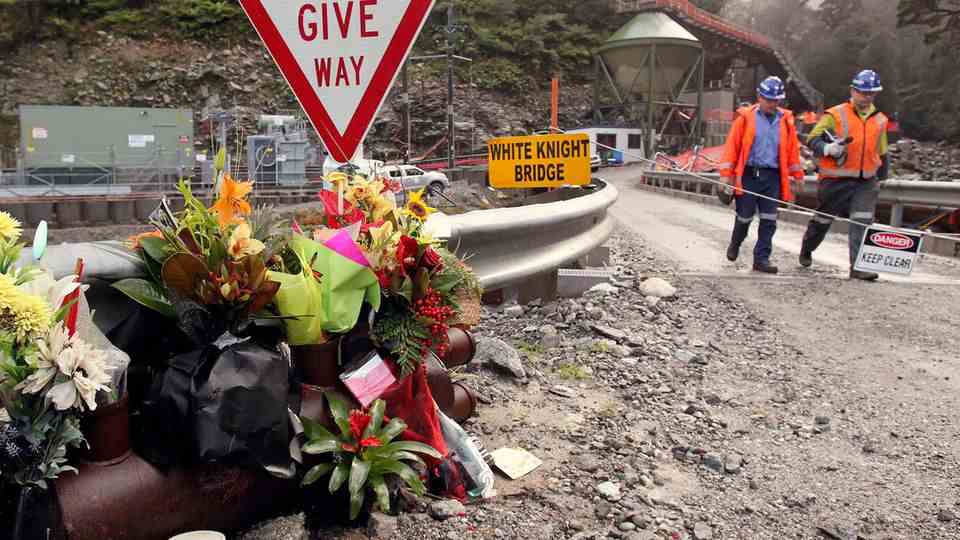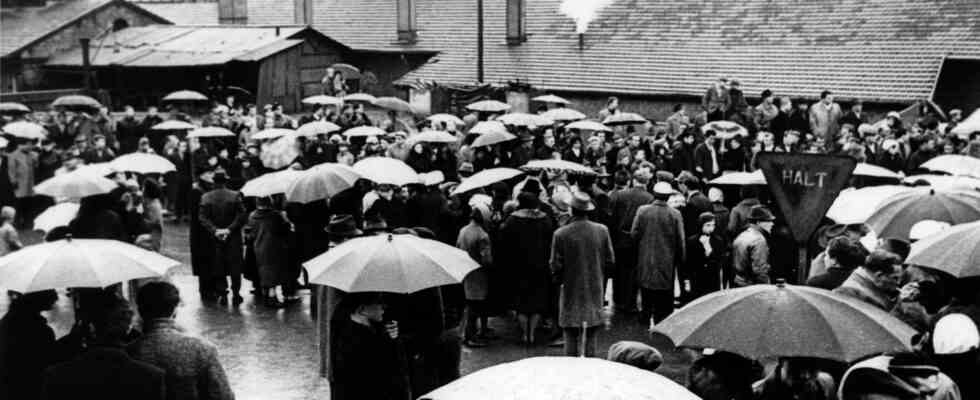February 7, 1962
Death came underground: the serious mining accident in Luisenthal
Desperate relatives have gathered in front of the entrance to the mine site after the Luisenthal mine accident
© Julius Schmidt / Picture Alliance
On February 7, 1962, a catastrophe occurs in the Luisenthal mine in Völklingen, Saarland. 299 miners lose their lives in a firedamp explosion. The cause of the worst mining accident in the history of Saar mining has not been clarified to this day.
It is a cold, wet Wednesday morning, February 7, 1962, when the early shift workers at the Luisenthal mine in Völklingen set off in the drizzle at around 6 a.m. to their 600-meter-deep workplace. The community in Saarland is known for coal mining and its hard coal mine, which is particularly rich in methane. It has already received several awards in the field of occupational safety and the last mine accident was 41 years ago. However, the pit is considered to be very susceptible to firedamp explosions.
Such a thing happened around 7.45 a.m. in the Alsbach shaft, one of four cableway shafts. The dull bang can be heard miles away. Under the force of the detonation, the manhole cover flies up and wedges itself in the struts of the manhole structure. A thick cloud of black smoke immediately billows over the winding tower. The workers underground hardly have a chance of escaping the barrage of fire that shoots through the Alsbachfeld in a matter of seconds. The blast collapses struts up to 100 meters long, tearing heavy iron doors from their moorings and simply throwing them away. Even miners who work at a greater distance from the explosion site are thrown meters down the corridors by the blast wave.
61 miners survive the mine accident in Luisenthal unscathed
Of the 411 miners working there, 61 miraculously escaped unharmed. Shortly after the accident, the first rescue workers arrive at the mine site. Then the first family members arrive at the scene of the accident, attracted by the sirens, sirens and helicopter rotors.
A survivor tells a TV station how he threw himself flat on the ground after hearing the bang: “I still put my hands in front of my face and when I opened my eyes for a moment, I only saw light. That was the flame.” Finally, a buddy ran past him whose face was completely burned. Another man’s pants burned: “I then deleted him.”
Mine accident claims 299 lives
First of all, eleven fatalities are mentioned. But within 24 hours the number of victims rose to 240. A dozen of the 73 injured died in hospital. In the end, the mine accident claimed 299 lives. The oldest victim is 59, the youngest just 16 years old.
Three days after the accident, which goes down as the worst in the history of Saar mining, 287 coffins are laid out in a park on the edge of the colliery. Around 5000 mourners gather around them to say goodbye to the dead miners. Among them was Federal President Karl Heinrich Lübke. Radio and television change their programs. All over Germany the flags are at half-mast. The Prime Minister at the time, Franz-Josef Röder (CDU), spoke of a “dark day for Saarland mining and the population”. From US President John F. Kennedy to Pope John XXIII. the list of senders of the many condolence telegrams is enough.
The cause of the disaster remains unclear
But how could a catastrophe of such proportions have happened in the first place? The fact is: The mine gas (methane gas) had developed into an explosive mixture with air. A single spark was enough to ignite it.
In its official investigation report, the mining authority lists 72 violations of safety regulations. Main deficiencies: gas accumulations were not eliminated, smoking may have taken place underground, one weather compartment was overcrowded, rock dust barriers were missing, others were in poor condition. A parliamentary investigative committee of the Saarland state parliament also came to the conclusion that the rock dust barriers, which were set up improperly, were an essential part of the extent of the disaster.
Trial ends with acquittals
Rock dust barriers are boards under the ridge of a route on which the finest non-combustible rock dust with properties precisely prescribed by the mountain police is piled up. They serve as protection against the propagation of almost all coal dust explosions. The pressure wave distributes the dust evenly in the cross-section of the route and destroys the radiant energy of the glowing carbon particles needed to propagate the explosion. The result: the flame goes out.
13 responsible persons are charged and have to face an eight-week trial before the Saarbrücken district court. For all it ends with an acquittal. The cause of the accident is still unclear to this day. Assumptions that a miner had illegally smoked underground or that a defective miner’s lamp was the reason for the explosion could never be proven.

The German coal mining industry takes the Luisenthal disaster as an opportunity to keep improving safety precautions. A year after the explosion, a memorial is erected in front of the colliery gate. The accident is still remembered every year today.
Sources: Federal Archives, Saarland Radio, ARDDPA, voelklingen-im-wandel.de, dasunluckvonluisenthal.de.tl


